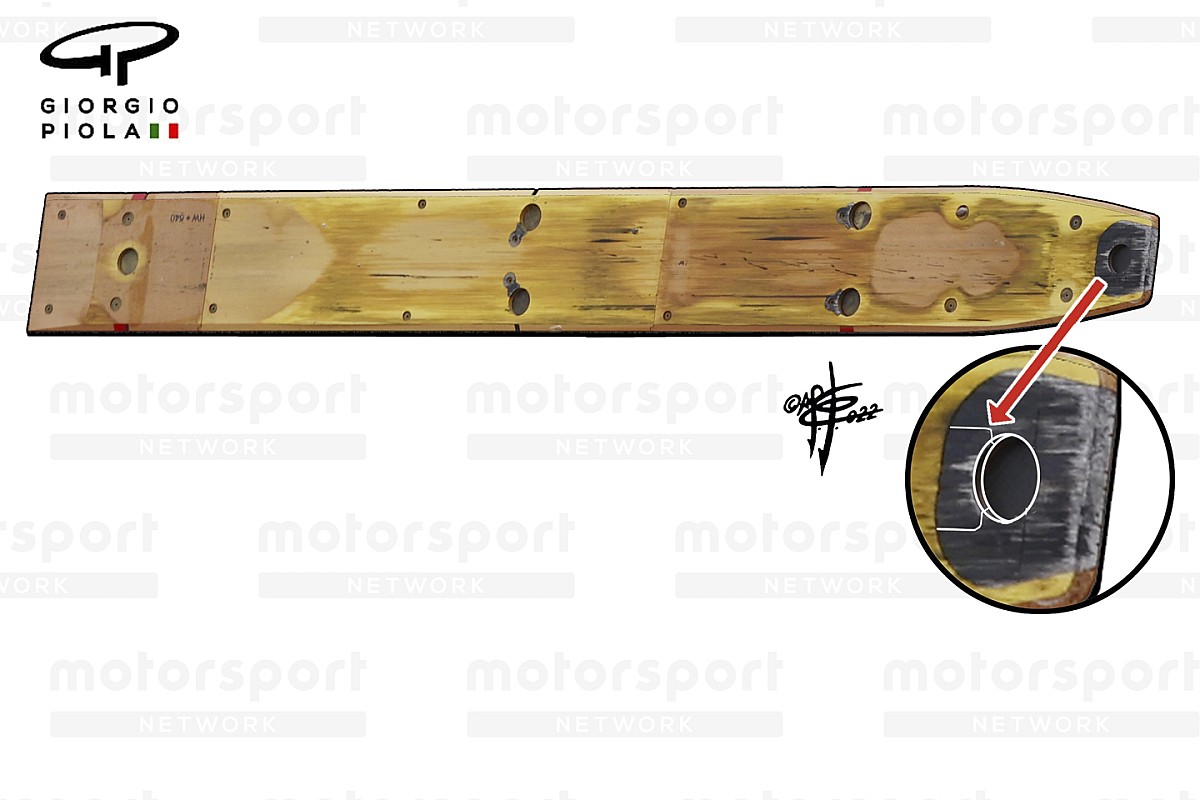The FIA has approved a series of technical changes that will modify the F1 cars from the Belgian GP and in particular the 2023 single-seaters: the International Federation has decided to act on its own free will, riding on the question of safety deriving from the alarmism that emerged after the GP of the Azerbaijan, when Lewis Hamilton and George Russell (Mercedes) complained about porpoising along with Carlos Sainz (Ferrari) and Pierre Gasly).
Baku’s violent hopping caused Hamilton’s back pain and the seven-time world champion provoked the FIA’s reaction with the TD39-2022. On a statistical level it is fair to remember that once Nikolas Tombazis’ document was written and corrected, Mercedes also stopped having strong pumping, especially after a new aerodynamic package and suspension changes that mitigate porpoising were introduced at Silverstone.
Ferrari F1-75: here is the discussed table under the body
Photo by: Giorgio Piola
But it is increasingly clear and evident that the FIA’s action in the short term aims at only one goal: to coax even the hopping, although an Aerodynamic Oscillation Metric (AOM) will be introduced from Spa-Francorchamps that the teams will be able to evaluate already at Paul Ricard and Hungaroring, but the attempt seems to be to bring the third top team of the world championship, Mercedes, back into the race, in order to expand the show in the second half of the season.
Is it justified to talk about security in the Technical Advisory Committee, the TAC that met on Thursday, where the International Federation has put forward its short and medium-term proposals that will have to be ratified as soon as possible by the World Council?
The FIA took the leap to write rules that the F1 Commission meeting in Spielberg had defined in the main and that the TAC on Thursday had to incorporate, although there are still some holes … blacks that still need to be clarified.
It may seem strange, but the teams have not yet received what will be the metric that will define whether a certain frequency of oscillation of the frame will be legal or not. Until now, the measurement took place through the accelerometer that the FIA mounts on each car near the center of gravity.

Zhou’s Alfa Romeo C42 after the rollover at Silverstone where the roll bar broke
Photo by: Steven Tee / Motorsport Images
This is the sensor with which the FIA detects the data of an accident (by the way, has no value been formalized about the crash of Guanyu Zhou?) And which are read in a specific telemetry channel reserved for the International Federation.
From Paul Ricard the calibration of that accelerometer will be changed, with a more sensitive and precise reading, and the AOM will be one of the channels available also in the telemetry of the teams. In the next two GPs the teams will be able to understand if the jumps will fall within the foreseen constraints or if they will be forced to raise their cars losing load.
But the bulk of the measures concerning Belgium are aimed at controlling the deformations of the skid blocks of the board. The goal is to hit Red Bull and Ferrari who have been able to interpret the 2022 rules with more intelligence or … cunning.

Ferrari and Red Bull are in the sights of the FIA for the flexibility of the board
Photo by: Glenn Dunbar / Motorsport Images
It must be said that RB18 and F1-75 are perfectly legal for technical checks: when the regulation forces are applied, the skid blocks do not deform, while when the single-seaters bulge on the curbs or on the asphalt, they fall back into the board mounted under the single-seaters, avoiding wear but allowing a lower set-up, capable of generating more aerodynamic load and, therefore, more performance.
No one has had the opportunity to see closely what the hell a skid block hides except the FIA technical commissioners, but we are talking about springs or sponges capable of making that portion of the skate that comes into contact with the asphalt disappear, inhibiting wear. These are obviously borderline concepts, like everything in F1, but it is strange that the rule is changed using safety, without there being any correlation with a possible danger.

Toto Wolff, Team Principal and CEO Mercedes AMG
Photo by: Mark Sutton / Motorsport Images
Toto Wolff said he was shocked at the Red Bull Ring when certain details were brought to light in the F1 Commission, but the feeling is that the inspector of the controls was precisely the Austrian manager who hopes to bring Mercedes back into play in the second part of the season.
Are we facing an FIA dominated by the Star or is there the intention to put a muzzle on those who pushed the interpretation of the rules to the limit of the spirit of the rules? It is all too evident that from Belgium the two top teams will lose something in order to change the rules in the race (will it also affect AlphaTauri and Haas who could have similar solutions?).
But if there is any doubt that someone has been clever because the FIA has not stopped him and you prefer to take the excuse of security to implement a measure that is not directly connected? We have just entered the … hot phase of this summer which promises to be hot not only from the weather point of view.
#safety #tool #change #rules #race








